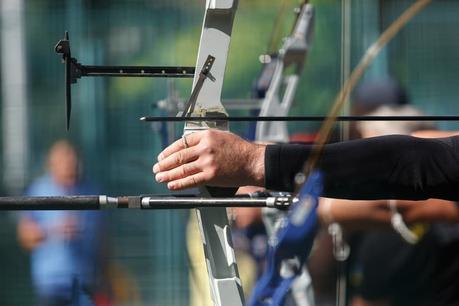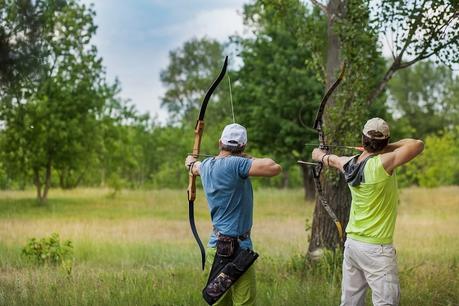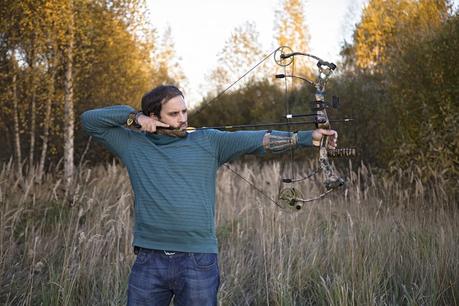
If you’re a new archer, it can be hard to understand what the different types of bows are, what the practical differences are between them, and which ones would be better in certain situations. We’ve written this guide to help you understand the difference between two of the most popular bows used today, the compound bow and the more traditional longbow.
If you look at a longbow and compound bow side by side, you’ll probably think that they couldn’t look more different. Compound bows are very modern looking with their cams, multiple bow strings, and nearly endless accessories, while a longbow tends to look like a stick someone just found outside and attached a string to.
They look completely different, but they both still shoot arrows, so can’t they be used for the same purposes? Let’s dig into their histories and uses and find out.
History
Longbow History
Longbows have been used as a weapon by different cultures for thousands of years. Where exactly they were invented is not known, but they have documented uses as far back as 1180 B.C.
Longbows were used most notably in Europe, but cultures across the world made use of these simple bows for defense and hunting. It fell out of use as a weapon as technology developed and people began to use guns instead.
Despite that, longbows are still used widely by archers who want a more traditional hunting or shooting experience.
Different types of longbows have been used throughout history, but the general definition of a longbow is any traditional bow where the string doesn’t contact the limbs, except for where it attaches at the limb tips.
A self bow is the simplest type of longbow, they are carved out of a single piece of wood. An English longbow was a type of longbow used in medieval Europe that was around six feet long.
Most modern longbows are a composite bow, also known as a laminated bow. This just means that the bow is constructed out of several laminated layers of wood.
This allows the bow to be made straighter, more resilient, and able to take advantage of the beneficial properties of several different kinds of wood. You can also get a takedown bow, which is a longbow or recurve bow that can be broken down into three pieces for storage and traveling.
Compound Bow History
Compound bows are a descendant of the recurve bow and longbow. Archers wanted bows that were quieter and smaller for hunting, and the first compound bows were created in the 1960’s to solve those problems.
They were created by sawing the ends off a recurve bow, and fitting it with a pulley system. These pulleys, today known as cams, are the biggest difference between a compound and longbow.
They create let-off, meaning that you only hold a small portion of the bows draw weight at full draw. This allowed archers to shoot heavier compound bows much easier than even light longbows.
The basic design of compound bows hasn’t changed much since their invention. However, they have technologically advanced over time to become much smaller and easier to shoot, making them ideal for bow hunting.
As the design evolved they eventually overtook recurve and longbows as the preferred bow for competition archery, and are now the most widely used bows in North America.

Uses
Uses of Compound Bows
The mechanical advantage of let-off makes compound bows much easier to learn and become accurate with. Compound bows are the most popular bows used in target archery, especially in 3d archery. Their small size and ease of use make them deadly accurate for bow hunting. There are even specially made compound bows with extremely high draw weights made for hunting large, exotic animals.
Uses of Longbows
While longbows are not as accurate as compound bows, they can be used for nearly everything you would use a compound bow for. Many archers actually find shooting a longbow for hunting and competition more rewarding than shooting a compound bow, because of how much harder it is to make accurate shots.
Pros and Cons
Compound Bow Pros and Cons
There are a lot of benefits to shooting a compound bow. Most people can shoot a compound bow much more accurately (and at a further distance) than they can a longbow.
Compound bows are almost always preferred for hunting, because of their superior speed, ease of use, and compact size. Compound bows are the most popular bow to use for many kinds of target archery, including 3d archery and indoor target archery. The main advantage of a compound bow is their mechanical advantage and let-off, making them easier to hold and shoot than a longbow.
The main disadvantage of a compound bow is how complex it is. There are a lot of different moving parts on the bow itself, all of which have the potential to wear out or break at inopportune times.
This also makes compound bows harder to set up and tune, because there are so many different factors to consider, especially when compared to a simple longbow. Compound bows are made to only be used with specific draw lengths and weights, which can make it difficult sometimes to find one that fits you correctly.
Longbow Pros and Cons
At first glance it may not seem like there are any pros to shooting a longbow over a compound bow. Compound bows may have the mechanical advantage, but there are plenty of other reasons a longbow might work better for you. One big one is the simplicity of longbows.
They’re just a stick and bowstring, so there’s no screws that will work their way loose, and no extra accessories to buy. A lot of archers prefer this simplicity even though they give up the mechanical advantage of a compound bow.
Similarly, traditional archers prefer to shoot a longbow because it is a simpler and more “pure” way to shoot a bow. There’s nothing on the bow that can influence your shot like a sight or stabilizer, so the only thing that makes or breaks your shots is yourself.
Even though shooting a longbow is much harder than shooting a compound bow, many archers are drawn to the satisfaction and challenge of this more traditional form of archery.
Longbows have their fair share of downsides. Arrows shot by them are much slower, and they’re much louder and have more hand shock. This can be mitigated by adding string silencers.
Longbows, like the name suggests, are much longer than compound bows, which can make them hard to maneuver in tight hunting situations. Finally, they have a higher learning curve than compound bows and will take much more target practice to develop accuracy.

Things to Know
If you are looking to buy a compound bow or longbow, there are a few more specific things you should consider about both bow types.
People often forget some of these things when buying a bow, and can end up with a bow that does not fit them correctly or doesn’t meet their expectations. Keep these in mind so that you can get the perfect bow for you.
Compound Bow
The most important thing to know about a compound bow is that they’re made for specific draw lengths and weights, so it’s vital to get a bow that fits your specs. Some bows, especially beginner compound bows, have an adjustable draw weight and/or length, so you can make your best guess and make adjustments after you buy your bow and start shooting.
When you’re first starting out, it’s a good idea to shoot as low of a draw weight as you can. You will be able to shoot more arrows to help you refine your technique without getting fatigued, and you will have less of a chance of injuring your shoulders.
The next thing you need to know about compound bows is that you will need some accessories in order to set up and start shooting your compound bow. Accessories that you will not be able to shoot without include an arrow rest, a bow sight, a peep sight, a d-loop, a release aid, and arrows.
There are also optional accessories that will make shooting easier or more enjoyable, like one or more stabilizers, a wrist sling, string silencers, or a magnified sight lens. Beginner compound bows often come in a package with everything you need to start shooting, but if you just buy a bare compound bow you’ll need to purchase and install those accessories before you can start shooting.
The last thing that you need to know is that there is a little bit of maintenance involved when you own and shoot a compound bow. Every time you shoot it is a good idea to check and make sure none of the screws or bolts on your bow is working itself loose.
It can be hard to find replacements for the tiny specialized screws used on compound bows and accessories. Bow strings also need maintenance. Your bow string will look fuzzy after a few weeks of shooting, which is fixed simply by applying some bow string wax to it. Bow strings and cables also need to be replaced when it gets worn out or frayed.
Longbow
One of the most important things to know about longbows are that they will not shoot as accurately as compound bows. This is because longbows are simpler and not as technologically advanced as compound bows, and compound bows have accessories like stabilizers and bow sights that further help their accuracy.
Because of this difference in accuracy, compound bows are also accurate at much further ranges than longbows are, which can be important to keep in mind when bow hunting.
Another thing to know about longbows is that you can use wooden arrows with them, and some archers prefer them over the more modern carbon or aluminum shaft arrows.
There are bowyers that can make you a set of wooden arrows for your specific longbow poundage and type, but many archers like to make them themselves. Making your own arrows can be a huge learning experience, but it is very rewarding to shoot and hunt with arrows you made from scratch.
Unlike compound bows, longbows do not have a specific draw length. This means that you can technically make any longbow work for you, although people with very long draw lengths will find it more comfortable to shoot a longer longbow, and vice versa.
You also will want to shoot a lower poundage with a longbow than you would shoot with a compound bow. The lack of let off means you’ll be holding your longbows full poundage, which will be much harder to shoot than using the same draw weight on a compound bow.
The last important thing to know about longbows is that they are very susceptible to weather and humidity changes. Since they are essentially just a piece of wood, they can shoot completely differently depending on the weather that day.
They should also not be left for long periods of time in vehicles, because the extreme temperatures can cause them to crack or delaminate. These problems are more noticeable on self bows, but laminated longbows can still be harmed by extreme heat or cold.
When Should You Use Which Bow Type?
There are a lot of different kinds of archery, and what types you plan on shooting will greatly impact which bow type will better suit you. In this section we will cover a few different common archery scenarios and situations, and discuss which bow type would best suit the situation.
Hunting
Both compound bows and longbows work well for bow hunting, but both have their pros and cons. A compound bow has the mechanical advantage over a longbow, and it’s not even close.
If you’ve never hunted before, or are not confident enough in your abilities to make good shots in stressful bow hunting situations, a compound bow is what you should be using. The mechanical advantage and lower learning curve make it so much easier to hunt with.
Another reason bow hunting beginners should use a compound bow is that it is extremely easy to go to a bow shop and buy a completely set up beginner compound bow. Any archery store (at least in North America) has a full stock of compound bows, accessories, and archery technicians that can set them up for you.
Those same archery shops may have one or two longbows, if you’re lucky. And if they do have a longbow in an appropriate draw weight for you, chances are they won’t have the accessories you need like wooden arrows or string silencers.
With all that said, longbows do have their place in bow hunting. Many bow hunters find that after years of bow hunting with a compound bow or crossbow that they want to try something new.
Experienced bow hunters that are looking for a new challenge won’t find anything better than the challenge of hunting and harvesting a deer with a longbow. The most experienced traditional bow hunters will even craft and hunt with their own longbow, wooden arrows, and bow string.

Target Archery
Archery competitions have different classes you can shoot in that are based on what equipment you are using. Most tournaments will have classes for any kind of bow you shoot, but some tournaments limit the classes they have.
That allows for archery tournament organizers to put on unique shoots like high-pressure money shoots, or traditional archery shoots where only longbows and other traditional bows are allowed.
Since compound bows are so much more accurate than longbows, competing with a compound bow is a high stakes competition where even one small mistake can cause you to lose. A lot of archers are drawn to this kind of competition, especially because you can win thousands of dollars in some compound archery competitions.
Competitions where you shoot a longbow tend to be more laid back. Everyone is going to make mistakes while shooting a longbow, so the stakes are lowered and the other competitors will probably seem more friendly and laid back.
As a trade off, longbows tend to not have many opportunities to compete for large amounts of prize money.
That wraps up our comparison of the longbow and compound bow. We hope it helped you better understand the difference between bow types, and makes your choice between them easier.
If you want to explore comparisons between even more bow types, then be sure to check out our Recurve vs. Compound Bows guide.
Glossary
Arrow Rest – A compound bow accessory that supports the arrow during your shot, and can be adjusted in order to tune your bow
String Silencers – An accessory made of string or rubber that attaches to your bow or bow string, in order to reduce noise and hand shock
Takedown Bow – A recurve or longbow that breaks down into three pieces for easy transport, and so you can switch out different limbs or risers

